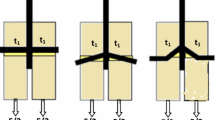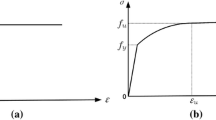Abstract
This study concerns the failure of dowel-type joints in glued laminated timber under static loading. Failure of joints with a single bolt or dowel due to cracking parllel to the grain direction is considered. Results presented concern only the first mode of cracking,i.e. splitting under tension perpendicular to the grain. Fracture is analyzed by the use of linear elastic fracture mechanics concepts; the crack propagation condition is assumed to be based upon the critical energy release rate GIc. A simplified average stress criterion allows predicting the onset of splitting.
An experimental program was carried out on joints for different structural parameters and bolt diameters. The experimental stable crack growth allowed obtaining the load-crack length curves. Another experimental program was carried out in order to compare the fracture energy of a few CIB-type specimens with the critical energy release rate GIc being used in the crack propagation simulation.
The comparison between experimental and numerical results for the simulation of fracture in joints shows that Linear Elastic Fracture Mechanics provides a good approximation of the load-bearing capacity of bolted joints and may help improve design codes.
Résumé
Le travail présenté conceme la modélisation et la simulation de la rupture d'un assemblage par tige métallique d'éléments de bois lamellé collé lorsque le phénomène majeur de dégradation est celui de la fissuration parallèlement au fil. Nous nous sommes pour l'instant limités à une sollicitation perpendiculaire aux fibres; l'amorçage et la propagation de la fissuration, en mode I dans ce cas, sont étudiés. L'analyse de la propagation d'une fissure est effectuée au moyen de la Mécanique Linéaire Élastique de la Rupture. L'amorçage de la fissuration est prédit par l'utilisation d'un critère simplifié prenant en compte la contrainte moyenne sur une distance supposée caractéristique du matériau.
Les simulations numériques sont comparées à des résultats d'expérimentations pour divers diamètres de tiges et paramètres structuraux. Nous comparons les valeurs simulées et expérimentales des forces d'amorçage de la fissuration ainsi que des forces maximales que l'assemblage peut supporter. Afin de vérifier que la valeur identifiée du taux de restitution d'énergie critique GIc est caractéristique du matérau, une campagne d'essais de fissuration parallèlement au fil du bois par flexion trois points a également été menée sur des éprouvettes de type CIB.
Cette étude montre que la Mécanique Linéaire Élastique de la Rupture peut être appliquée pour la simulation de la rupture d'un assemblage et peut être un outil pour l'amélioration des codes de dimensionnement des assemblages lorsque le phénomène majeur de dégradation du bois est celui de la fissuration parallèlement au fil.
Similar content being viewed by others
References
Johansen, K.W. ‘Theory of Timber Connections’, Inter Assoc. of Bridge and Structural Engineering, Bern, Switzerland, Publ. 9. (1949) 249–262.
‘EUROCODE 5—Design of Timber Structure’, ENV 1995-1-1, CEN, Brussels (1993).
Yasumura, M., Murota, T. and Sakai, H., ‘Ultimate Properties of Bolted Joints in Glued-laminated Timber’, CIB-W18A Meeting, paper 20-7-3 (1987).
Yasumura, M., ‘Japan Overview: Design concept and prospect of bolted joints and nailed joints’, Proceedings of International Workshop on Wood Connectors., Ed. Forest Products Society, ISBN 0.935018.56.5., (1993) 114–121.
Canadian Standards Association, ‘Engineering Design in Wood (Limit States Design)’, National Standard of Canada CAN/CSA-086.1-M89. CSA, Rexdale Ont., Canada (1989).
Ehlbeck, J., Gorlacher, R. and Werner, H., ‘Determination of Perpendicular-to-grain Tensile Stresses in Joints with Dowel-type-fasteners’, CIB-W18A Meeting, Berlin Germany, paper 22-7-2 (1989).
Rahman, M.U., Chiang, Y.J. and Rowlands, R.E. ‘Stress and failure analysis of double-bolted joints in Douglas-fir and Sitka spruce”,Wood and Fiber Science 23 (4) (1991) 567–589.
Bouchaïr, A., ‘Modélisation non Linéaire du Comportement Local des Assemblages Bois’, Thèse de l'Université Blaise Pascal, Clermont-Ferrand (1993).
Whitney, J.M. and Nuismer, R.J.,Journal of Composite Materials 8, (1974) 253–265.
Larsen, H.J. and Gustafsson, P.J., ‘Design of End-notched Beams’, CIB-W18A Meeting, Berlin Germany, paper 22-10-1 (1989).
Valentin, G. and Adjanohoun, G., ‘Applicability of classical isotropic fracture mechanics specimens to wood crack propagation studies,’Materials and Structures 25 (1992) 3–13.
Valentin, G., Boström, L., Gustafsson, P.J., Ranta-Maunus, A. and Gowda, S., ‘Application of Fracture Mechanics to Timber Structures’, RILEM State-of-the-art Report, Technical Research Centre of Finland. Espoo Finland, Research Notes 1262, ISBN 951.38.3891.1 (1991).
Boström, L., ‘The fictitious crack model—A fracture mechanics approach applied to wood’, International Conference on Timber Engineering, Seattle, 2 (1988) 559–565.
Bengougam, A. and Dubois, F., ‘Simulation de la Rupture d'un Assemblage en Bois Boulonné’, LMT, Mémoire de D.E.A. de l'ENS. de Cachan (1994).
Gautherin, M.T., ‘Critère de Contrainte Limite du Bois Massif, LMT, Thèse de l'Université Paris 6 (1980).
Johnson, J.A., ‘Crack initiation in wood plates’,Wood Sci. 6 (2) (1973) 151–158.
Guitard, D., ‘Mécanique du Matériau Bois et Composites’, Cépadues-Éditions, ISBN 2.85428.152.7 (1987).
CTBA, ‘Étude des Caractéristiques Mécaniques du Sapin et de l'Épicéa—France Entière’, Internal report.
Rathkjen, A., ‘Failure Criteria for Wood’, in ‘Failure Criteria of Structured Media’, Boehler (ed.) (Balkema, Rotterdam, The Netherlands), ISBN 9.06191. 179.6. (1993).
Sobue, N., ‘Scientific Report for the “Grant-in Aid Scientific Research”, n0 62560174, Ministry of Education, Science and Culture, Japan (1989).
Griffith, A., ‘The Phenomena of Rupture and Flow in Solids’, Philosophical Transactions of the Royal Society of London, Series A, 221 (1920) 163–198.
Nallathambi, P. and Karihaloo, B.L., ‘Notched beam test: Mode I Fracture Toughness’ Fracture Mechanics Tests for Concrete, Report of Technical Committee 89-FMT, RILEM, edited by Shah, S.P. and Carpinteri, A. (Chapman and Hall, London, 1991) 1–86.
Larsen, H.J. and Gustafsson, P.J., ‘The Fracture Energy of Wood in Tension Perpendicular to the Grain’, CIB-W18A Meeting, Lisbon Portugal, paper 23-19-2 (1990).
Daudeville, L., Yasumura, M. and Lanvin, J.D., ‘Fracture of Wood in Tension Perpendicular to the Grain: Numerical Simulation by Damage Mechanics’, CIB-W18A meeting, Copenhagen, Denmark, paper 28-19-1 (1995).
Author information
Authors and Affiliations
Additional information
Editorial note Laurent Daudeville works at the Laboratoire de Mécanique et de Technologie, École Normale Supérieur, Cachan. This laboratory is a RILEM Associate Member.
Rights and permissions
About this article
Cite this article
Daudeville, L., Yasumura, M. Failure analysis of timber bolted joints by fracture mechanics. Mat. Struct. 29, 418–425 (1996). https://doi.org/10.1007/BF02485992
Issue Date:
DOI: https://doi.org/10.1007/BF02485992




